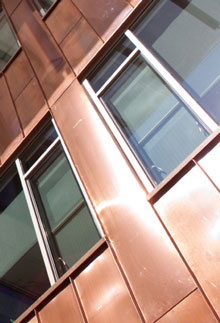New Metal on Campus
Willamette University turns to copper for exterior walls and solar PV panels
Sustainability, "going green" and environmental conservation are a few hot button topics everyone in new construction has been hearing or talking about over the past few years. For many, this is only talk, or the incorporation of new "gadgets", for others it is a call to rebuilding their design process from the ground up to make smart, sustainable choices throughout the building project.
Willamette University's newest academic building, Ford Hall, is one such project that exemplifies sustainability throughout.
The $19.6 million architectural marvel opened in the fall of 2009. This new structure houses the departments of rhetoric and media studies, computer science, mathematics, digital art, film studies and music technology. It encompasses 42,000 square feet of highly efficient building space complimented by the beauty of copper wall cladding.
 Exterior copper wall panels, Willamette University. Photo by Michael Mathers courtesy of Hennebery Eddy Architects, Inc.
Exterior copper wall panels, Willamette University. Photo by Michael Mathers courtesy of Hennebery Eddy Architects, Inc.
High-resolution version of this photo.
This new addition to the Willamette campus, located in the heart of Salem, OR, is the university's second project to earn LEED Gold status. Ford Hall attained this designation in part through the integration of copper in the overall design.
"There are so many aspects of copper that can fit the sustainable mold when designing buildings like these," said Andy Kireta Jr., vice president of building construction for the Copper Development Association (CDA). "It allows architects and designers to think about sustainable design, without sacrificing the look they might be trying to achieve."
In the case of Ford Hall, copper sheeting of high recycled content was attached to the exterior wall panels, bringing a natural beauty to the building that will slowly and gracefully age through the life of the building. But unlike the saying, in this building the beauty of copper is more than skin deep. More than 4,000 square feet of photovoltaic solar panels, all interconnected with safe, efficient and reliable copper wiring are installed on the building's roof, which provide 26.8 kilowatts to the campus grid. In addition, long lasting copper piping delivers safe drinking water throughout the building, and is integral in the motors and heat exchangers of the Hall's highly efficient heating and cooling systems.
Designed by Hennebery Eddy Architects and built by Hoffman Construction Company, both of Portland, OR, the construction of Ford Hall was accomplished in just 14 months.
"The most sustainable building is one that does not get torn down," said Doug P. Reimer, project manager for Henneberry Eddy Architects. "The building was designed to last 100 years and offers flexibility for future renovations, so we selected materials such as copper that endure the test of time."
Reimer also went on to say that copper is used in several other buildings on campus. From a design perspective, the architects used natural materials (brick, limestone and copper) that develop patina or have a natural range of color that work well together. Cu
Also in this Issue:
- Copper Alternative Joining Systems: A+
- New Metal on Campus
- Power Quality on Campus: Electrical Infrastructure is a Top Priority at Renowned Computing Center
- Antimicrobial Copper at the Head of the Class
- An Education in Copper
